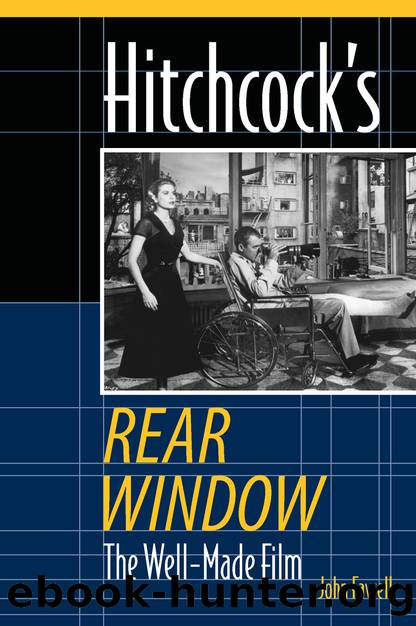Hitchcock's Rear Window by John Fawell

Author:John Fawell [Fawell, John]
Language: eng
Format: epub
ISBN: 9780809389704
Publisher: Southern Illinois University Press
6
Playing the Windows Game 2: The Lonely Hearts
After the Thorwaldsâ window, the most featured and important has to be Miss Lonelyheartsâs window. Miss Lonelyhearts is the only neighbor, beside Lars Thorwald and his wife, to survive from Cornell Woolrichâs original story. She seems a descendant of the young widow in Woolrichâs story who would put her child to bed and then âsit there painting her eyes and mouth.â Once, the narrator relates, âI was still up, and I looked and she was sitting there motionless with her head buried in her arms. Something about it, it used to make me a little sad.â1
Lisa is the one who most often projects herself into Miss Lonelyheartsâs window. âWell, at least thatâs something youâll never have to worry about,â Jeff says to Lisa as he watches Miss Lonelyhearts weep at her dinner table after entertaining her imaginary suitor. He assumes the youthful, glamorous Lisa has nothing in common with the old maid. âOh, you can see my apartment up on Sixty-third Street all the way from here,â responds Lisa, emphasizing that she is not as different from Miss Lonelyhearts as Jeff thinks she is. Hitchcock certainly agrees. If Mrs. Thorwald represents the strongest physical parallel to Lisa, Miss Lonelyhearts represents the strongest emotional parallel.
The scene that makes the connection between Miss Lonelyhearts and Lisa clear is the carefully arranged one that occurs in the wake of Jeff and Lisaâs angry conversation in which Jeff informs Lisa that he cannot see a future to their relationship. The heated conversation finishes with Jeff taking a very rude and condescending tone. âLetâs just stop talking nonsense, shall we,â he tells Lisa, who sets off forlornly to the kitchen to prepare their dinner. As so often happens in this film, the dialogue between Jeff and Lisa sets the tone for, or serves as a prelude to, what happens next in the windows across the way. Jeff has hurt Lisa. It is an easy jump here to the sad Miss Lonelyhearts. Hitchcock is careful to maintain consistency between the mood in Jeffâs apartment and the mood across the court.
Still, Hitchcock does not take us directly into Miss Lonelyheartsâs apartment. When Jeff looks across the courtyard, he first focuses on Mrs. Thorwald in her bed. Only then, in a very geometrical pan down, does he take us to Miss Lonelyheartsâs apartment. By starting with Mrs. Thorwald and then moving to Miss Lonelyhearts, Hitchcock emphasizes that Miss Lonelyhearts is picking up from where Mrs. Thorwald left off (she had been the subject of our last window viewing) and that both are united as Lisaâs reflection.
The song âTo See You Is to Love Youâ that serves as background music to Miss Lonelyheartsâs sad imaginary date represents yet another ironic commentary on Jeff, who seems to have so much more feeling for the women he watches than the one who is in the room with him. Moments after being so cruel to Lisa, he turns a deeply sympathetic eye on Miss Lonelyhearts, to the point of being willing to take on the role of Miss Lonelyheartsâs imaginary lover.
Download
This site does not store any files on its server. We only index and link to content provided by other sites. Please contact the content providers to delete copyright contents if any and email us, we'll remove relevant links or contents immediately.
The Kite Runner by Khaled Hosseini(5133)
Gerald's Game by Stephen King(4607)
Dialogue by Robert McKee(4353)
The Perils of Being Moderately Famous by Soha Ali Khan(4194)
The 101 Dalmatians by Dodie Smith(3482)
Story: Substance, Structure, Style and the Principles of Screenwriting by Robert McKee(3420)
The Pixar Touch by David A. Price(3389)
Confessions of a Video Vixen by Karrine Steffans(3273)
How Music Works by David Byrne(3234)
Harry Potter 4 - Harry Potter and The Goblet of Fire by J.K.Rowling(3031)
Fantastic Beasts: The Crimes of Grindelwald by J. K. Rowling(3029)
Slugfest by Reed Tucker(2972)
The Mental Game of Writing: How to Overcome Obstacles, Stay Creative and Productive, and Free Your Mind for Success by James Scott Bell(2876)
4 - Harry Potter and the Goblet of Fire by J.K. Rowling(2683)
Screenplay: The Foundations of Screenwriting by Syd Field(2602)
The Complete H. P. Lovecraft Reader by H.P. Lovecraft(2529)
Scandals of Classic Hollywood: Sex, Deviance, and Drama from the Golden Age of American Cinema by Anne Helen Petersen(2491)
Wildflower by Drew Barrymore(2466)
Robin by Dave Itzkoff(2411)
